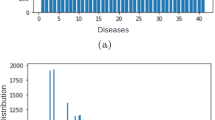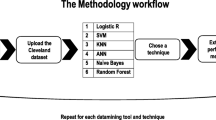Abstract
One of the most essential and fundamental factors that motivates people to seek assistance is their physical well-being. A vast range of ailments affect people nowadays, making them extremely vulnerable. Thus, disease prediction at an early stage has now become increasingly relevant as a result of these developments. Machine Learning is a relatively new technique that can aid in the prediction and diagnosis of diseases. To diagnose respiratory difficulties, heart attacks, and liver disorders, this study employs machine learning in conjunction with symptoms. All these diseases are the focus of our investigation because they are extremely prevalent, incredibly expensive to treat, and impact a significant number of people at the same time. A variety of supervised machine learning methods, including Naive Bayes, Decision Trees, Logistic Regression, and Random Forests, are used to forecast the disease based on the provided dataset. The discussion of learning categorization based on correctness ends with this conclusion. Flask is also used to construct a platform that allows visitors to forecast whether they will contract a specific illness and take appropriate precautions if they do contract the illness. Among the most important aspects of healthcare informatics is the prediction of chronic diseases. It is critical to diagnose the condition at the earliest possible opportunity. Using feature extraction and classification methods for classification and prognosis of chronic diseases, this study gives a summary of the current state of the art. The selection of elements that are appropriate for a classification system is critical in improving its accuracy. The decrease of dimensionality aids in the improvement of the overall performance of the machine learning system. The use of classification algorithms on disease datasets gives promising results in the development of adaptive, automated, and smart medical diagnostics for chronic diseases, according to the researchers. Using parallel classification systems, it is possible to speed up the process while also increasing the computing efficiency of the final findings. This paper provides a complete analysis of several feature selection strategies, as well as the advantages and disadvantages of each method.
Access this chapter
Tax calculation will be finalised at checkout
Purchases are for personal use only
Similar content being viewed by others
References
Huang, L.C., Wu, X., Chen, J.Y.: Predicting adverse side effects of drugs. BMC Genomics 12(Suppl. 5), S11 (2011)
Pauwels, E., Stoven, V., Yamanishi, Y.: Predicting drug side-effect profiles: a chemical fragment-based approach. BMC Bioinform. 12, 169 (2011)
Nilashi, M.I., Bin Ahmadi, O., Leila, H.S.: An analytical method for diseases prediction using machine learning techniques. Comput. Chem. Eng. 106, 212–223 (2017)
Dimitri, G.M., Lio, P.: DrugClust: a machine learning approach for drugs side effects prediction. Comput. Biol. Chem. 68, 204–210 (2017)
Rajeswari, P., SophiaReena, G.: Analysis of liver disorder using data mining algorithm. Global J. Comput. Sci. Technol. 10(14), 48–52 (2010)
Karthik, S., Priyadarishini, A., Anuradha, J., Tripathy, B.K.: Classification and rule extraction using rough set for diagnosis of liver disease and its types. Adv. Appl. Sci. Res. (2011)
Rama Sree, S., Ramesh, S.N.S.V.S.C.: Artificial intelligence aided diagnosis of chronic kidney disease. J. Crit. Rev. 7(12), 909–923 (2020)
A Comparative Analysis for Various Stroke Prediction Techniques. www.researchgate.net/publication/340250948
Maheswari, S., Pitchai, R.: Heart disease prediction system using decision tree and Naive Bayes algorithm. Curr. Med. Imaging Rev. 15(8), 712–717 (2019). https://doi.org/10.2174/1573405614666180322141259
Ali, M.M., Paul, B.K., Ahmed, K., Bui, F.M., Quinn, J.M.W., Moni, M.A.: Heart disease prediction using supervised machine learning algorithms: performance analysis and comparison. Comput. Biol. Med. 136, 104672 (2021). https://doi.org/10.1016/j.compbiomed.2021.104672
Balakrishnan, B., Vinoth, K.C.N.S.: A comprehensive performance analysis of various classifier models for coronary artery disease prediction. Int. J. Cogn. Inform. Nat. Intell. 15(4), 1–14 (2021). https://doi.org/10.4018/IJCINI.20211001.oa36
Rani, P., Kumar, R., Ahmed, N.M.O.S., Jain, A.: A decision support system for heart disease prediction based upon machine learning. J. Reliable Intell. Environ. 7(3), 263–275 (2021). https://doi.org/10.1007/s40860-021-00133-6
Latha, C.B.C., Jeeva, S.C.: Improving the accuracy of prediction of heart disease risk based on ensemble classification techniques. Inform. Med. Unlock. 16, 100203 (2019). https://doi.org/10.1016/j.imu.2019.100203
Li, L., Yu, X., Yong, Z., Li, C., Gu, Y.: Design comorbidity portfolios to improve treatment cost prediction of asthma using machine learning. IEEE J. Biomed. Health Inform. 25(6), 2237–2247 (2021). https://doi.org/10.1109/JBHI.2020.3034092
Author information
Authors and Affiliations
Corresponding author
Editor information
Editors and Affiliations
Rights and permissions
Copyright information
© 2022 Springer Nature Switzerland AG
About this paper
Cite this paper
Rama Sree, S., Vanathi, A., Veluri, R.K., Ramesh, S.N.S.V.S.C. (2022). A Comparative Study on a Disease Prediction System Using Machine Learning Algorithms. In: Dev, A., Agrawal, S.S., Sharma, A. (eds) Artificial Intelligence and Speech Technology. AIST 2021. Communications in Computer and Information Science, vol 1546. Springer, Cham. https://doi.org/10.1007/978-3-030-95711-7_41
Download citation
DOI: https://doi.org/10.1007/978-3-030-95711-7_41
Published:
Publisher Name: Springer, Cham
Print ISBN: 978-3-030-95710-0
Online ISBN: 978-3-030-95711-7
eBook Packages: Computer ScienceComputer Science (R0)




